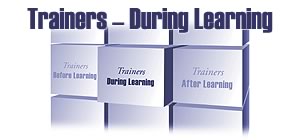Provide work-related exercises and appropriate job aids
Throughout your course, you should make every effort to help learners draw upon what
they already know and connect what they are learning to what they need to
do on the job. The design of your course should include activities and exercises
to promote the transfer of learning. Here are some ways to facilitate this
process during your course:
- Design activities that engage learners as
participants and tap their existing knowledge and skills.
- Include realistic exercises that address the challenges being faced
by the learners at their work sites. Consider brainstorming with the participants
early in the course to focus on problems at their facilities and then use
those problems as the basis for activities throughout the course.
- Schedule learning topics in short segments
integrated with practice exercises and activities.
- Provide frequent opportunities for learners
to reflect on what they are learning and plan how they will use their new
knowledge and skills on the job. Give them a notebook to use as a learning
journal. Periodically ask the learners specific questions to
answer in their journals about how they will apply their new knowledge and skills, what
challenges they may face and how they will overcome those challenges. Suggest
that learners keep track of problems and questions they need to resolve
and resources they will need to put new skills into practice. Remind learners
to refer to their written reflections as they refine their action plans.
- Provide opportunities for learners to support
each other by giving each other feedback and discussing how they will use
their new knowledge and skills.
- Help learners identify or develop job aids
they can use to promote the transfer of learning (e.g., a poster describing
correct hand washing technique to hang on the wall near the sink). Have
learners practice using job aids in situations similar to those
on the job.
Give immediate and clear feedback
Most workers have a strong need and desire to know how they
are doing on the job. Supervisors and trainers are encouraged to provide immediate,
individualized and clear feedback in order to reinforce learners' desired behaviors.
There are numerous opportunities during a course for you to
provide feedback to learners:
- during presentations and small-group activities
when all learners can benefit from the shared feedback
- individually during skill
practice sessions or while marking knowledge tests
- during breaks when you can
approach learners or encourage them to approach you
- during clinical training when learners are working with clients (though this may be a more challenging opportunity).
Use a variety of techniques to help ensure that feedback is
timely and meaningful, including:
- verbal feedback, such as positive behavior reinforcement or constructive correction
- nonverbal feedback, such as smiling and nodding during presentations.
Help learners develop realistic action plans
Supervisors and learners are encouraged to capture training
expectations by developing preliminary action plans prior to beginning a course.
With guidance from trainers, learners develop a more complete action plan
during the course. As a trainer, you are in a unique position to help learners
decide which skills they need more practice with and how best to structure
their practice after the course. If a learner's preliminary plan was not a
formal written plan, you can provide an action plan
format that will help the learner formalize a plan. See "What
is an action plan?" for information about action plans.
Conduct training evaluations
Each training course should have an evaluation component. During
a course you may administer several types of evaluations including:
- pre-course knowledge and skills
assessments to determine whether learners have the prerequisite knowledge and skills
- interim knowledge and skills assessments
to measure learners' progress
- post-course knowledge and skills assessments
to determine whether learners have achieved the course objectives and are
performing to course standards
- course evaluations to give
learners an opportunity
to provide feedback on how well the course was conducted, whether the course
materials were appropriate and how well the course content met
their performance needs.
Skills assessments or evaluations are typically based on performing
a skill to a standard as detailed in a performance checklist. After training,
these checklists can be used on the job in a number of different ways. For example:
- learners can use them as a job aid when applying the skill
- supervisors can use them to coach learners as they practice a new skill
- trainers can use them during follow-up visits to observe and provide feedback to learners.
When used over time, checklists can be helpful in tracking
changes in performance from one observation point to the next.
| 